A Study on Information Strategy Planning (ISP) for Applying Smart Technologies to Airport Facilities in South Korea
Abstract
1. Introduction
1.1. Background and Necessity of the Study
1.2. Purpose of the Study
1.3. Research Methodology
2. Literature Review
2.1. Strategic Framework for Smart Airport Implementation
2.2. Facility Information Integration and Maintenance Strategy
3. Materials and Methods
3.1. Object and Scope of Airport Facility Information
3.2. Airport Facility Classification and Legacy Linkage in South Korea
3.3. Current Status of Stakeholders and Related Organizations
4. Analysis of Management System for Domestic Airport Facilities and Derivation of Priority Tasks
4.1. Analysis of Airport Work Classification System and Standards
4.2. Risk Factors and Success Strategies Through Benchmarking Leading Cases
4.3. Improvement Directions and Implementation Tasks Through SWOT Analysis
4.4. Core Implementation Tasks and Priorities for Airport Facility Information
4.5. Model Concept Design and Data Acquisition According to Standard Component Technology
5. Detailed Design of ISP Model for Applying Smart Technology to Airport Facility Information (To-Be Model)
5.1. Technology Environment Design
5.2. Work Standards Design
5.3. Organizational Environment Design
6. Discussion: Detailed Information on Goals and Steps
7. Conclusions
7.1. Summary of Key Findings
7.2. Future Directions
Author Contributions
Funding
Data Availability Statement
Conflicts of Interest
References
- Kang, J.-O.; Kim, J.-H.; Park, Y.-K.; Yoon, H.-T.; Choi, S.-M. A Development of libraries for BIM Design of railway infrastructure and Establishment of sharing system. J. Korea Acad.-Ind. Coop. Soc. 2024, 25, 790–803. [Google Scholar] [CrossRef]
- Lee, H.-M.; Lee, I.-S.; Moon, H.-S.; Kim, H.-S. Implementation of BIM-Based Automated Road Route Design System. J. Korean Inst. Commun. Inf. Sci. 2023, 48, 107–113. [Google Scholar] [CrossRef]
- Baghalzadeh Shishehgarkhaneh, M.; Moradinia, S.F.; Keivani, A.; Azizi, M. Application of classic and novel metaheuristic algorithms in a BIM-based resource Tradeoff in dam projects. Smart Cities 2022, 5, 1441–1464. [Google Scholar] [CrossRef]
- Jung, E.; Kim, K.W.; Choi, Y.C. Development of Common Data Standard for Airports Facilities Based on Building Information Modeling (BIM). J. Korean Soc. Aviat. Aeronaut. 2021, 29, 100–110. [Google Scholar] [CrossRef]
- Ministry of Land, Infrastructure and Transport (MOLIT). Development Project of Smart Construction Technology Preliminary Feasibility Report; Korea Agency for Infrastructure Technology Advancement (KAIA): Anyang-si, Republic of Korea, 2018. [Google Scholar]
- Ministry of Land, Infrastructure and Transport (MOLIT). 5th Construction CALS Master Plan; Korea Institute of Civil Engineering and Building Technology (KICT): Goyang, Republic of Korea, 2017. [Google Scholar]
- Dassult System. End-To-End Collaboration Enabled by BIM Level 3. 2021. Available online: https://www.3ds.com/fileadmin/Industries/Architecture-Engineering-Construction/Pdf/Whitepapers/end-to-end-collaboration-enabled-by-bim-level-3-white-paper-aec.pdf (accessed on 1 March 2025).
- Ministry of Land, Infrastructure and Transport (MOLIT). Construction Industry BIM Basic Guidelines; Ministry of Land, Infrastructure and Transport (MOLIT): Sejong, Republic of Korea, 2020. [Google Scholar]
- IATA. 20-Year Air Passenger Forecast 2024: International Air Transport Association. 2024. Available online: https://www.iata.org/en/publications/store/ (accessed on 1 March 2025).
- Lee, H.J.A. Study of Airport Capacity Delay Analysis. Master’s Thesis, Hanseo University, Seosan, Republic of Korea, 2020. [Google Scholar]
- Moon, S.B.; Jeong, W.Y.; Jeong, U.S.; Park, J.Y. Integrated life-cycle management technology for airport facilities based on digital twin. J. Korea Road Assoc. 2022, 24, 21–26. [Google Scholar]
- Liu, R. Comparative analysis of critical factors for BIM adoption in airport. Theor. Nat. Sci. 2023, 19, 265–274. [Google Scholar] [CrossRef]
- Keskin, B.; Salman, B. Building information modeling implementation framework for smart airport life cycle management. Transp. Res. Rec. 2020, 2674, 98–112. [Google Scholar] [CrossRef]
- Biancardo, S.; Viscione, N.; Oreto, C.; Veropalumbo, R.; Abbondati, F. BIM Approach for Modeling Airports Terminal Expansion. Infrastructures 2020, 5, 41. [Google Scholar] [CrossRef]
- Brown, A.W.; Pitt, M. Measuring the facilities management influence in delivering sustainable airport development and expansion. Facilities 2001, 19, 222–232. [Google Scholar] [CrossRef]
- Cha, S.H. A study on the design direction of an integrated operation platform for the realization of digital-based smart airport. In Proceedings of the 2022 Spring Conference of the Korean Society for Quality Management, Seoul, Republic of Korea, 20 May 2022; Volume 58. [Google Scholar]
- Koseoglu, O.; Arayıcı, Y. Airport Building Information Modelling; Routledge: London, UK, 2019. [Google Scholar] [CrossRef]
- Abdelalim, A.M.; Essawy, A.; Salem, M.; Al-Adwani, M.; Sherif, A. Optimizing Facilities Management Through Artificial Intelligence and Digital Twin Technology in Mega Facilities. Sustainability 2025, 17, 1826. [Google Scholar] [CrossRef]
- Asare, K.A.; Liu, R.; Anumba, C.J. Building information modelling for airport facility management: The case of a US airport. Infrastruct. Asset Manag. 2023, 11, 3–14. [Google Scholar] [CrossRef]
- Kim, D.Y. Data analysis for facility maintenance based on BIM-Case studies of facility maintenance based on BIM and practical process. J. KIBIM 2020, 10, 1–11. [Google Scholar] [CrossRef]
- Keskin, B.; Salman, B.; Koseoglu, O. Architecting a BIM-based digital twin platform for airport asset management: A model-based system engineering with SysML approach. J. Constr. Eng. Manag. 2022, 148, 04022020. [Google Scholar] [CrossRef]
- Shin, M.H.; Kim, J.M.; Baek, J.H. A study on UI standards for building a life-cycle integrated management system based on BIM for railway infrastructure. J. Korean Soc. Railw. 2021, 24, 746–755. [Google Scholar] [CrossRef]
- Hong, J.W.; Park, K.R.; Kim, D.H. A study of environment analysis method for information strategy planning based scenarios. J. Digit. Converg. 2016, 14, 195–203. [Google Scholar] [CrossRef]
- Ye, Q.; Zhang, Q.; Yang, N.; Wang, P. An Empirical Study of Big Data Based Information Strategy (BDBIS) for Resource Enterprises. J. Comput. 2016, 27. [Google Scholar]
- Kim, J.-Y.; Lee, B.-S. A study on the integrated ISP methodology linking EA and BPR. J. Korea Inst. Inf. Technol. 2012, 10, 201–212. [Google Scholar]
- Kim, J.-Y. A Study on the Integrated ISP Methodology Based on Ontology. Ph.D. Dissertation, Incheon National University, Incheon, Republic of Korea, 2013. [Google Scholar]
- Shin, J.-E.; Cho, D.-G.; Kim, B.-I.; Ko, Y.-M.; Ki, Y.-M.; Jung, I.-S.; Kang, S.-H.; Park, J.-S.; Kwak, M.-S.; Hwang, H. Strategy for establishing national healthcare information strategy plan (ISP). J. Korean Inst. Ind. Eng. 2016, 42, 198–208. [Google Scholar]
- Isnadi, I.; Suparno, S.; Putra, I.N.; Sukandari, B. Strategic Planning of Information and Technology Systems of Indonesian Naval Academy. J. ASRO 2018, 9, 48–62. [Google Scholar] [CrossRef]
- Ward, J.; Peppard, J. Strategic Planning for Information Systems, 3rd ed.; Wiley: Chichester, UK, 2007; Volume 28. [Google Scholar]
- Dias, C.; Silva, J. Unveiling the future: Smart airports—Applications, advantages, strategies and technological challenges. J. Airl. Airpt. Manag. 2024, 14, 38–56. [Google Scholar] [CrossRef]
- Jayasuriya, N.A.; Rajapaksha, A. Smart airport: A review on future of the airport operation. Glob. J. Manag. Bus. Res. 2020, 20, 25–34. [Google Scholar] [CrossRef]
- Narongou, D.; Sun, Z. Applying intelligent big data analytics in a smart airport business: Value, adoption, and challenges. In Handbook of Research on Foundations and Applications of Intelligent Business Analytics; Sun, Z., Ed.; IGI Global: Hershey, PA, USA, 2022; pp. 216–237. [Google Scholar]
- Javaherikhah, A.; Sarvari, H. Implementing Building Information Modeling to Enhance Smart Airport Facility Management: An AHP-SWOT Approach. CivilEng 2025, 6, 15. [Google Scholar] [CrossRef]
- Glendinning, S.; Hall, J.; Manning, L. Asset-management strategies for infrastructure embankments. In Proceedings of the Institution of Civil Engineers-Engineering Sustainability; Thomas Telford Ltd.: London, UK, 2009; Volume 162, pp. 111–120. [Google Scholar]
- ORR (Office of Rail and Road). Annual Report on Asset Management and Infrastructure Performance; ORR (Office of Rail and Road): London, UK, 2021. [Google Scholar]
- Bertolini, L.; Ciampoli, L.B.; Pinto, R.; Benedetto, A. Survey of airport facilities: Novel approaches. In Earth Resources and Environmental Remote Sensing/GIS Applications XIV; SPIE: Nuremberg, Germany, 2023; Volume 12734, pp. 202–210. [Google Scholar]
- Naghshbandi, F. Building information modeling (BIM) and the impact on collaborative communication. Procedia Eng. 2017, 196, 763–770. [Google Scholar]
- Teicholz, P. (Ed.) BIM for Facility Managers; John Wiley & Sons: Hoboken, NJ, USA, 2013. [Google Scholar]
- Eastman, C.; Teicholz, P.; Sacks, R.; Liston, K. BIM Handbook: A Guide to Building Information Modeling for Owners, Managers, Designers, Engineers and Contractors, 2nd ed.; Wiley: Hoboken, NJ, USA, 2011. [Google Scholar]
- ISO 19650-1:2018; Organization and Digitization of Information about Buildings and Civil Engineering Works, Including Building Information Modelling (BIM)—Information Management Using Building Information Modelling—Part 1: Concepts and Principles. International Organization for Standardization: Geneva, Switzerland, 2018.
- ISO 19650-2:2018; Organization and Digitization of Information about Buildings and Civil Engineering Works, Including Building Information Modelling (BIM)—Information Management Using Building Information Modelling—Part 2: Delivery Phase of the Assets. International Organization for Standardization: Geneva, Switzerland, 2018.
- Wijekoon, C.; Manewa, A.; Ross, A.D. Enhancing the value of facilities information management (FIM) through BIM integration. Eng. Constr. Archit. Manag. 2020, 27, 809–824. [Google Scholar] [CrossRef]
- Aziz, N.D.; Nawawi, A.H.; Ariff, N.R.M. Building information modelling (BIM) in facilities management: Opportunities to be considered by facility managers. Procedia-Soc. Behav. Sci. 2016, 234, 353–362. [Google Scholar] [CrossRef]
- Matarneh, S.; Danso-Amoako, M.; Al-Bizri, S.; Gaterell, M.; Matarneh, R. BIM-based facilities information: Streamlining the information exchange process. J. Eng. Des. Technol. 2019, 17, 1304–1322. [Google Scholar] [CrossRef]
- Lavy, S.; Saxena, N.; Dixit, M. Effects of BIM and COBie database facility management on work order processing times: Case study. J. Perform. Constr. Facil. 2019, 33, 04019069. [Google Scholar] [CrossRef]
- Wetzel, E.M.; Thabet, W.Y. The use of a BIM-based framework to support safe facility management processes. Autom. Constr. 2015, 60, 12–24. [Google Scholar] [CrossRef]
- Air Portal Information System. Available online: https://www.airportal.go.kr (accessed on 4 April 2025).
- Yang, S.H.; Kim, M.N.; Jeon, Y.J.; Ahn, J.B.; Lee, B.G.; Jung, Y.G. A case study on improving facility classification systems of domestic airport passenger terminals. Proc. Archit. Inst. Korea Conf. 2018, 38, 751–754. [Google Scholar]
- Sohn, S.-C.; Yoon, H.-Y. A Research on Applying Digital Transformation on Airport to Achieve Innovative Business Model in Airport Operation After COVID-19. J. Korea Acad.-Ind. Coop. Soc. 2022, 23, 483–492. [Google Scholar] [CrossRef]
- Korea Airports Corporation(KAC). Available online: https://www.airport.co.kr (accessed on 4 April 2025).
- Kim, E.; Yun, J.; Cho, S. Integrated Space and Asset Management System for Large Scale Airport. In Proceedings of the 20th Conference CAADRIA, Daegu, Republic of Korea, 20–22 May 2015; pp. 806–816. [Google Scholar] [CrossRef]
- Kim, E.Y. A study on 3D space management system through the Incheon International Airport integrated spatial management system project. In Proceedings of the Korea CDE Conference, Daejeon, Republic of Korea, 23–28 August 2015; pp. 316–321. [Google Scholar]
- Kwon, S.; Jung, J.; Cho, N.; Choi, H.; Kim, H.; Chung, H.; Park, B.; Cheon, S. Implementation of an Integrated Management System for Incheon Airport’s Smart Digital Door Locks. In Proceedings of the Korean Institute of Electromagnetic Engineering and Science Conference, Jeju, Republic of Korea, 2–5 June 2023; pp. 2454–2455. Available online: https://www.dbpia.co.kr/Journal/articleDetail?nodeId=NODE11522696 (accessed on 22 June 2025).
- Pinnacle Infotech. How BIM Technology Streamlined the Expansion of Abu Dhabi International Airport. 2023. Available online: https://pinnacleiit.com/blogs/abu-dhabi-international-airport-bim-technology-streamlined-its-expansion/ (accessed on 26 March 2025).
- Solibri. Auckland Airport: The Role of the Client in Improving BIM Quality for Asset Management. 2021. Available online: https://www.solibri.com/articles/auckland-airport-improve-bim-quality-for-asset-management (accessed on 26 March 2025).
- Solibri. Case Copenhagen Airport–Improving Quality and Collaboration. 2020. Available online: https://www.solibri.com/articles/cph-airport-improved-quality-collaboration (accessed on 26 March 2025).
- Tekla. Hotel Hilton Helsinki-Vantaa Airport: BIM Improves the Quality of Construction. 2022. Available online: https://www.tekla.com/resources/case-studies/hotel-hilton-helsinki-vantaa-airport-bim-improves-the-quality-of-construction (accessed on 26 March 2025).
- FIG. Helsinki Airport BIM Project. 2017. Available online: https://www.oicrf.org/-/helsinki-airport-bim-project (accessed on 26 March 2025).
- Jia, Z.; Lv, J. Overview of the Application of Digital Construction in Airport Construction. In Proceedings of the IOP Conference Series: Earth and Environmental Science: 6th International Conference on Hydraulic and Civil Engineering, Xi'an, China, 11–13 December 2020; IOP Publishing: Bristol, UK, 2021; Volume 643, p. 012181. [Google Scholar] [CrossRef]
- Koseoglu, O.; Sakin, M.; Arayici, Y. Exploring the BIM and lean synergies in the Istanbul Grand Airport construction project. Eng. Constr. Archit. Manag. 2018, 25, 1339–1354. [Google Scholar] [CrossRef]
- International Airport Review. Hong Kong International Airport (HKIA) Accelerates Its Digital Transformation. 2018. Available online: https://www.internationalairportreview.com/article/70324/hong-kong-international-airport-hkia-accelerates-its-digital-transformation/ (accessed on 26 March 2025).
- BIM Community. BIM in Turkey: The Use of BIM on the Istanbul Grand Airport. 2018. Available online: https://www.bimcommunity.com/bim-projects/bim-in-turkey-the-use-of-bim-on-the-istanbul-grand-airport/ (accessed on 26 March 2025).
- AECbytes. Jewel Changi Airport: Project Profile. 2019. Available online: https://www.aecbytes.com/profile/2019/ProjectProfile-JewelChangiAirport.html (accessed on 26 March 2025).
- Schiphol. Schiphol Smart Building 2030. 2022. Available online: https://www.schiphol.nl/en/download/b2b/1603709743/2kLIpQv5J5hsdHrh4faNY9.pdf (accessed on 26 March 2025).
- Ball, M. Denver’s Airport Expansion Primes a Push Toward BIM for Facility Management. 2015. Informed Infrastructure. Available online: https://damassets.autodesk.net/content/dam/autodesk/www/case-studies/denver-international-airport/dia-bim-for-facility-management.pdf (accessed on 26 March 2025).
- The B1M. Managing Denver International Airport with BIM. 2019. Available online: https://www.theb1m.com/video/managing-denver-international-airport-with-bim (accessed on 26 March 2025).
- buildingSMART International. Avinor Team T: Oslo Airport Terminal Expansion Using openBIM. 2018. Available online: https://www.buildingsmart.org/wp-content/uploads/2019/04/bSI_cCase_Study_2018_Avinor_Team_T.pdf (accessed on 26 March 2025).
- Informed Infrastructure. Oslo Airport Expansion: OpenBIM Approach Improves Project Efficiency. 2015. Available online: https://informedinfrastructure.com/17553/oslo-airport-expansion-open-bim-approach-improves-project-efficiency/ (accessed on 26 March 2025).
- Ghazinoory, S.; Abdi, M.; Azadegan-Mehr, M. SWOT methodology: A state-of-the-art review for the past, a framework for the future. J. Bus. Econ. Manag. 2010, 12, 24–48. [Google Scholar] [CrossRef]
- Jackson, S.E.; Joshi, A.; Erhardt, N.L. Recent research on team and organizational diversity: SWOT analysis and implications. J. Manag. 2003, 29, 801–830. [Google Scholar]
- Comino, E.; Ferretti, V. Indicators-based spatial SWOT analysis: Supporting the strategic planning and management of complex territorial systems. Ecol. Indic. 2016, 60, 1104–1117. [Google Scholar] [CrossRef]
- Mapulanga, P. SWOT analysis in the planning of information services and systems in university libraries: The case of the University of Malawi strategic plans. Bottom Line 2013, 26, 70–84. [Google Scholar] [CrossRef]
- Kim, D.H.; Ahn, B.J.; Kim, J.H.; Kim, J.J. The strategic approach using SWOT analysis to develop an intelligent program management information system (iPMIS) for urban renewal projects. In Proceedings of the 2009 Fourth International Conference on Computer Sciences and Convergence Information Technology, Seoul, Republic of Korea, 24–26 November 2009; IEEE: Piscataway, NJ, USA, 2009; pp. 320–324. [Google Scholar]
- Lemian, D.; Bode, F. Digital twins in the building sector: Implementation and key features. E3S Web Conf. 2025, 608, 05004. [Google Scholar] [CrossRef]
- Biagini, C.; Bongini, A.; Marzi, L. From BIM to digital twin. IOT data integration in asset management platform. J. Inf. Technol. Constr. 2024, 29, 1103–1127. [Google Scholar] [CrossRef]
- Ellul, C.; Hamilton, N.B.; Pieri, A.; Floros, G. Exploring Data for Construction Digital Twins: Building Health and Safety and Progress Monitoring Twins Using the Unreal Gaming Engine. Buildings 2024, 14, 2216. [Google Scholar] [CrossRef]
- Ramonell, C.; Chacón, R.; Posada, H. Knowledge graph-based data integration system for digital twins of built assets. Autom. Constr. 2023, 156, 105109. [Google Scholar] [CrossRef]
- Xu, X.; Ma, L.; Ding, L. A framework for BIM-enabled life-cycle information management of construction project. Int. J. Adv. Robot. Syst. 2014, 11, 126. [Google Scholar] [CrossRef]
- PAS 1192-2:2013; Specification for Information Management for the Capital/Delivery Phase of Construction Projects Using Building Information Modelling. British Standards Institution: London, UK, 2013.
- PAS 1192-3:2014; Specification for Information Management for the Operational Phase of Assets Using Building Information Modelling. British Standards Institution: London, UK, 2014.
- Balakrishnan, H.; Clarke, J.P.; Feron, E.M.; Hansman, R.J.; Jimenez, H. Challenges in aerospace decision and control: Air transportation systems. In Advances in Control System Technology for Aerospace Applications; Springer: Berlin/Heidelberg, Germany, 2015; pp. 109–136. [Google Scholar]
- da Cruz, A.L.M. Transforming air traffic management with big data and artificial intelligence. Int. Seven Multidiscip. J. 2024, 1. [Google Scholar] [CrossRef]
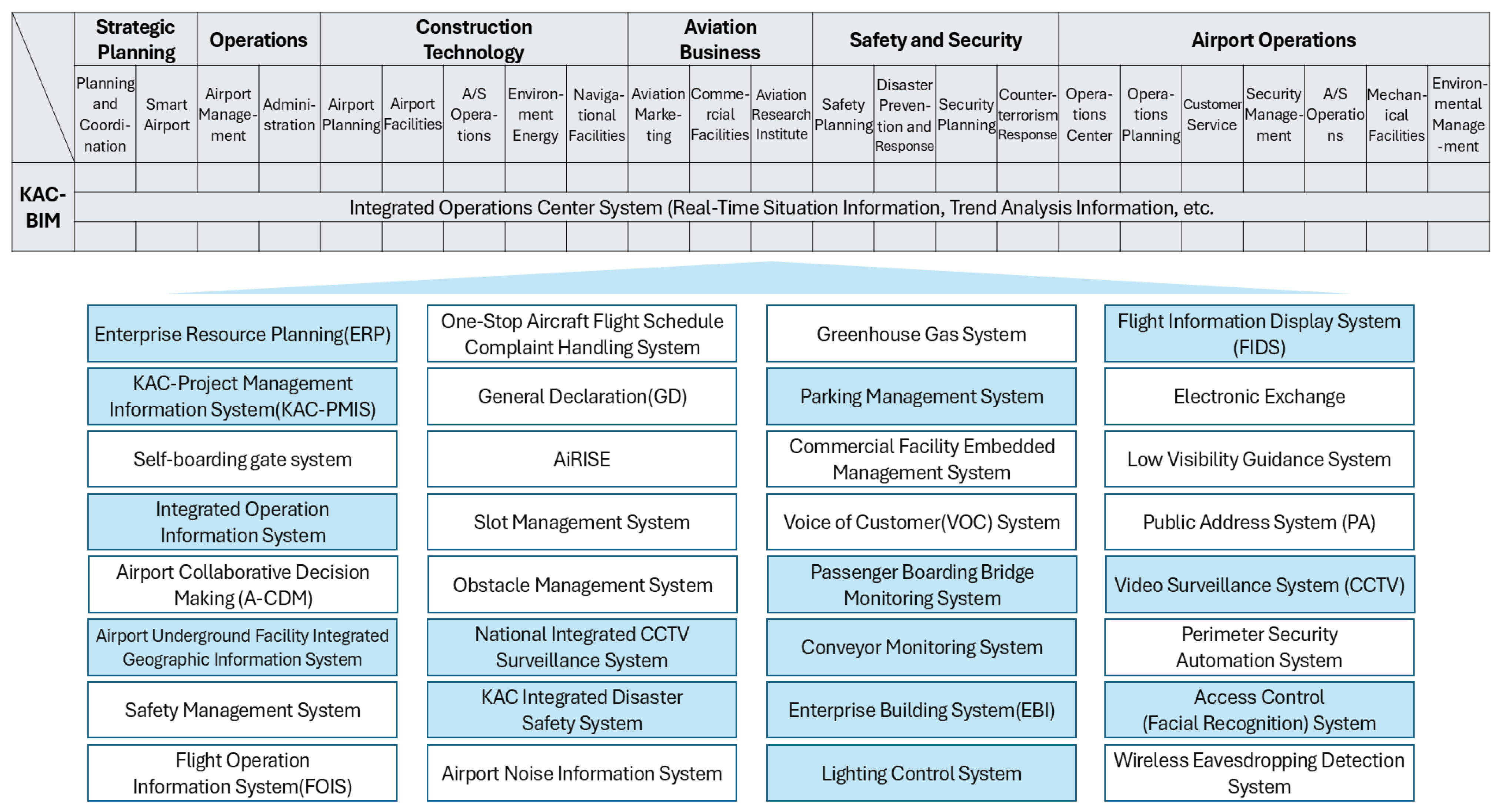

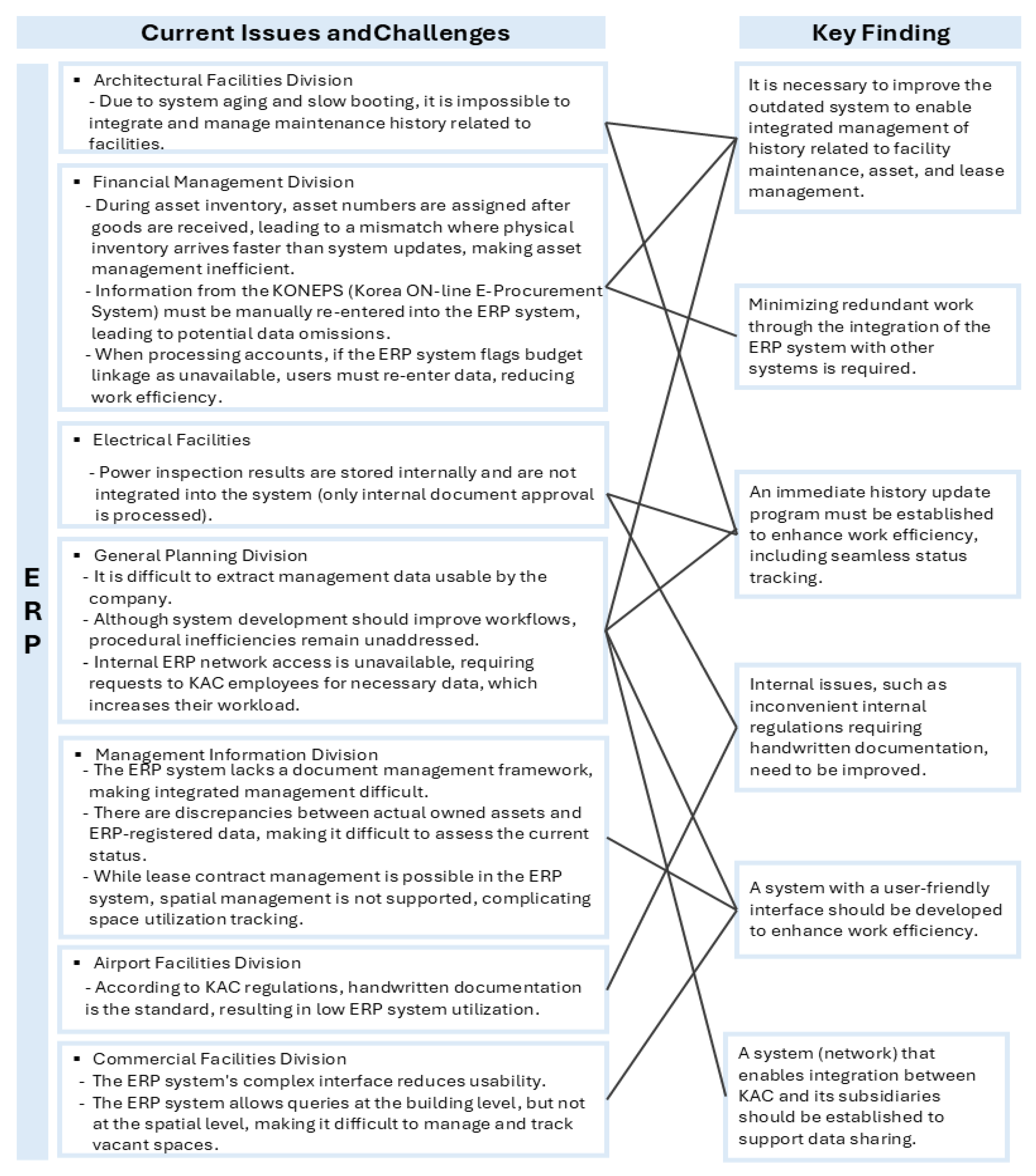
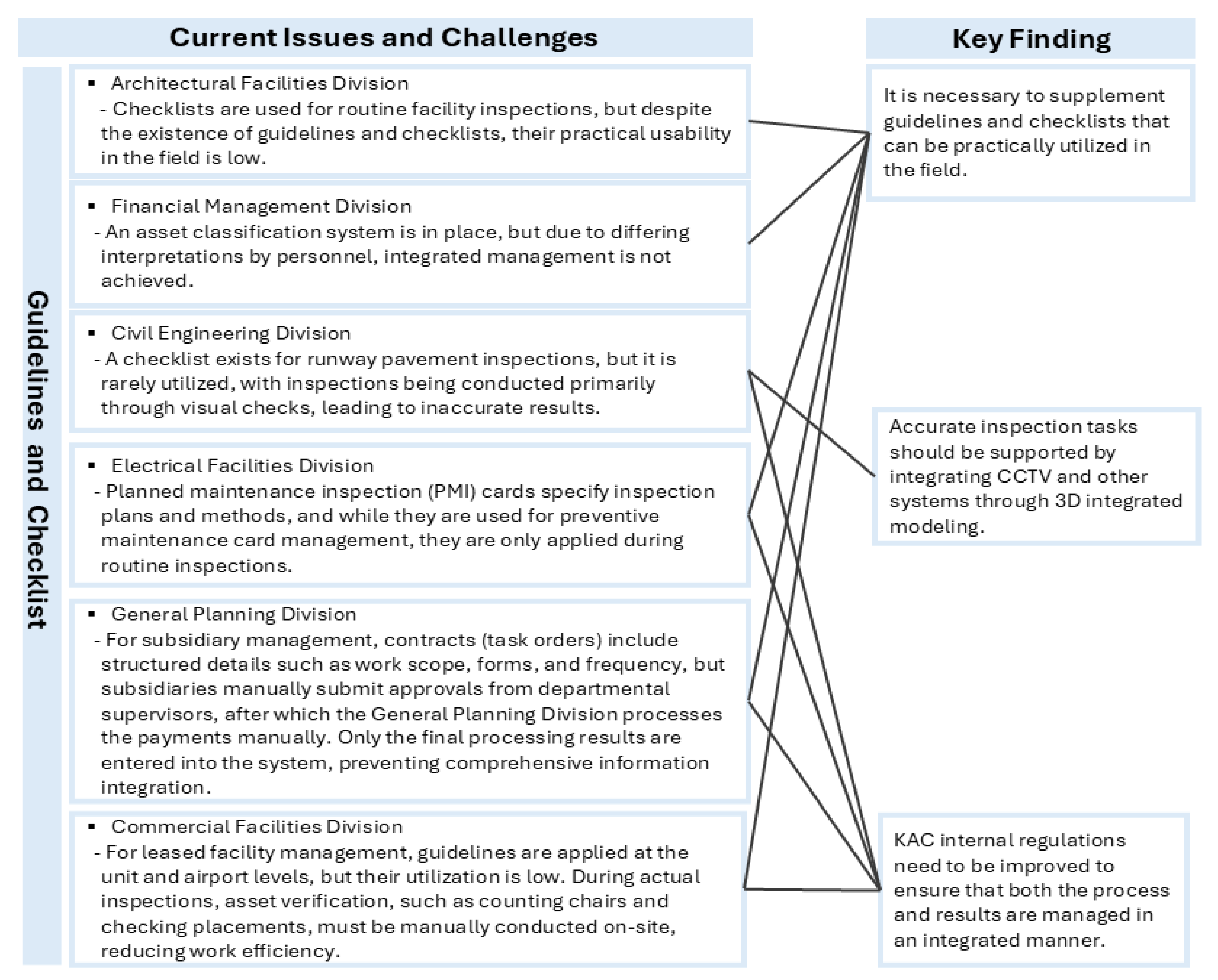

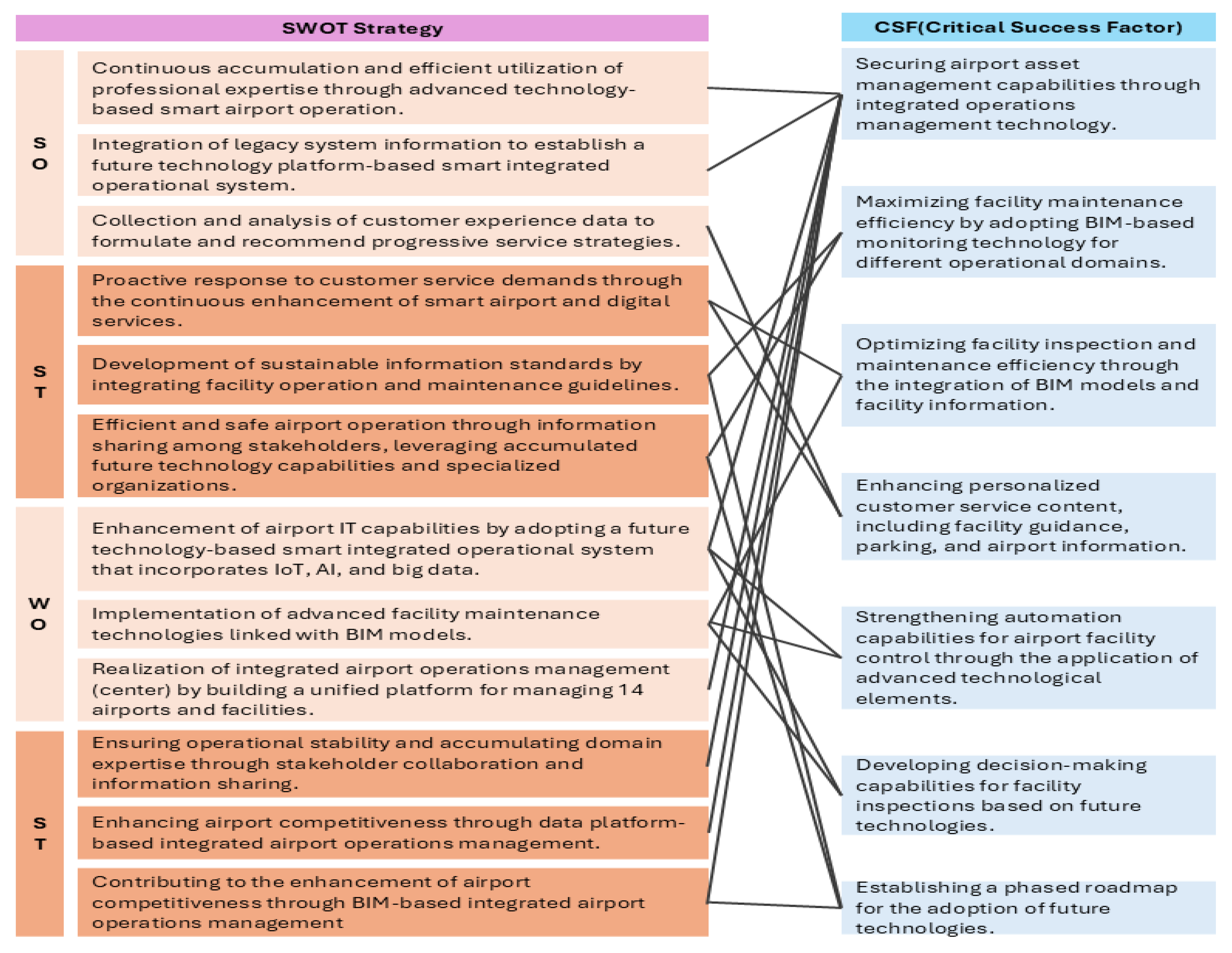

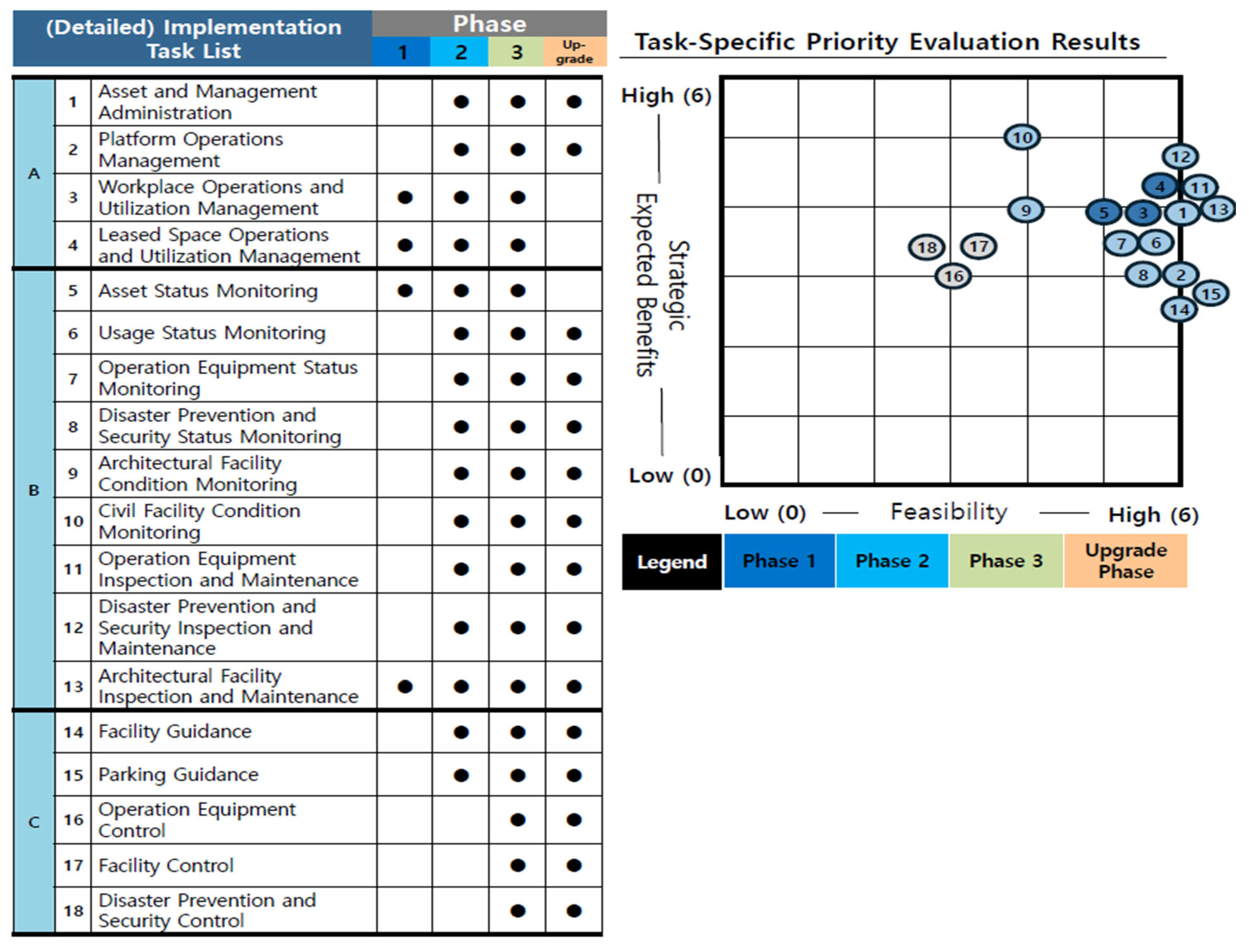


| Step | Research Procedure | Research Method |
|---|---|---|
| Step 1 Environmental Analysis |
|
|
| Step 2 Current State Analysis (AS-IS) |
|
|
| Step 3 Target Model Design (TO-BE) |
|
|
| Step 4 Action Plan Formulation |
|
|
| Airport | Site Area (m2) | Length and Width of Runway (m) | Terminal Area (m2) | Aircraft Departures (Times/ Year) | Mid- to Long-Term Development Directions and Issues |
|---|---|---|---|---|---|
| Gimpo | 8,440,923 | 3600 × 45 3200 × 60 | Domestic: 77,776 International: 53,087 | 226,000 |
|
| Gimhae | 3,697,435 | 2743 × 45 3200 × 60 | Domestic: 37,282 International: 50,665 | 200,000 |
|
| Jeju | 3,497,380 | 3180 × 45 1900 × 45 | Domestic: 45,145 International: 27,818 | 172,000 |
|
| Daegu | 6,617,283 | 2755 × 45 2743 × 45 | Domestic: 11,985 International: 15,008 | 140,000 |
|
| Gwangju | 5,854,564 | 2835 × 45 2835 × 45 | Domestic: 10,561- | 140,000 |
|
| Cheongju | 6,739,778 | 2744 × 60 2744 × 45 | Domestic: 8000 International: 14,406 | 140,000 |
|
| Yangyang | 2,488,500 | 2500 × 45 | Domestic: 10,083 International: 16,047 | 43,000 |
|
| Muan | 2,682,000 | 2800 × 45 | Domestic: 20,000 International: 9106 | 140,000 |
|
| Yeosu | 1,330,930 | 2100 × 45 | Domestic: 13,328 | 60,000 |
|
| Ulsan | 919,977 | 2000 × 45 | Domestic: 8886 | 60,000 |
|
| Pohang | 4,035,563 | 2133 × 45 | Domestic: 11,707 | 100,000 |
|
| Sacheon | 4,039,465 | 2743 × 45 2743 × 45 | Domestic: 4692 | 165,000 |
|
| Gusan | 142,803 | 2743 × 45 2454 × 23 | Domestic: 2852 | 140,000 |
|
| Wonju | 5,675,650 | 2743 × 45 | Domestic: 1896 | 115,000 |
|
| Facility Classification According to Airport Design Standards | Remark | |||
|---|---|---|---|---|
| Large Category | Mid-Category | Small Category | Detailed Facilities | |
| Passenger facilities | Check-in and Ticketing | Departure | Self-check-in | Newly added |
| Self-baggage drop | Newly added | |||
| Ticketing and baggage check-in | ||||
| ID check | Newly added | |||
| Departure security check | ||||
| Departure passport check | ||||
| - | ||||
| Arrival | Alien/immigrant quarantine | |||
| Alien/immigrant passport check | ||||
| Arrival security check | ||||
| Baggage claim | ||||
| Customs clearance and animal and plant quarantine | ||||
| Connection | - | |||
| Transfer security check | ||||
| Transfer counter | ||||
| Gate areas | General | Departure gate area | ||
| Arrival gate area | ||||
| Separated | Boarding area | |||
| Hallways | Departure hallway | Renamed | ||
| Arrival hallway | Facility classification | |||
| Public facilities | Public hall, open hallways, stairs, elevators, fixed boarding bridges, and restrooms | Facility classification | ||
| Commercial and convenience facilities | Infant and child facilities, Internet zones, various information booths, duty-free shops, duty-free shop storages, business lounges, and food stalls | |||
| Passenger-related facilities | Airline facilities | Airliner offices, ground crew offices, airline lounges, and hallways within airline facilities | ||
| Government facilities | Resident agency offices, break rooms, gyms, and hallways within governmental facilities | |||
| Airport management facilities | Employee facilities, employee cafeterias, VIP/CIP lounge, and hallways within management facilities (separately planned for airport management facilities) | |||
| Support facilities | - | Baggage claims | Facility classification | |
| MEP facilities | Mechanical, electrical, telecommunications, firefighting facilities, and water tank room | |||
| Category | Title | Created in | Objectives | Major Detail |
|---|---|---|---|---|
| Rental Management Manual | Rental Manual | September 2011 | Intended to describe how to use a rental agreement so that users can easily process the rental agreement |
|
| Property Management Manual | Standard Information Management | - | Intended to enable users to easily apply procedures in managing the assets of the KAC on the master level |
|
| Standards for Processing Property Tasks | October 2015 | Intended to promote efficient property management by preparing standards for handling property work that occurs during airport development projects |
| |
| User Reference for Property Tasks | April 2014 | Intended to enable users to easily apply procedures in managing the assets of the KAC |
| |
| Environmental Management Manual | Airport Environmental Inspection Handbook | October 2018 | Intended to train environmental management personnel at each airport in eliminating blind spots in inspections and implementing environment-friendly airports by producing and distributing a response manual for repeatedly emerging issues during environmental inspections by MOLIT, local governments, and other related organizations |
|
| Facility Maintenance Manual | Maintenance Guidelines for Building Facilities | May 2019 | Intended to facilitate the smooth operation of air transport and passenger services through efficient management and maintenance by establishing inspection and maintenance procedures for building facilities managed and operated by the KAC |
|
| Risk Factors | Success Strategies |
|---|---|
| Difficulty in securing existing data | Securing shape data and classifying attribute data through new BIM application projects |
| Difficulty in developing internal standards | Establishing an openBIM-based system through early construction of a library linked to national and international standards |
| Difficulty in responding to high technological innovation speed | Expanding the system stepwise through the down/up method with a system module unit (puzzle strategy—e.g., Schiphol Airport) |
| Difficulty in building a perfect digital twin | Deriving a buildable model through setting a short-term scope |
| Distinction | Analysis Results | |
|---|---|---|
| Internal capabilities to be considered | S |
|
| W |
| |
| External environment to respond to | O |
|
| T |
| |
| Integrated Implementation Tasks | Implementation Tasks | Detailed Description | |
|---|---|---|---|
| Asset Integration Management | 1 | openBIM-based integrated asset operation management |
|
| 2 | openBIM-based facility and space use management |
| |
| Facility Maintenance | 3 | openBIM-based facility status monitoring |
|
| 4 | openBIM-based facility control |
| |
| 5 | openBIM-based facility inspection and maintenance |
| |
| Facility Use Support | 6 | openBIM-based facility use guide |
|
| 7 | openBIM-based event occurrence guide |
| |
| Integrated Implementation Tasks | Implementation Tasks | Detailed Implementation Tasks | |
|---|---|---|---|
| Asset Integration Management | 1 | openBIM-based integrated asset operation management | 1.1 Asset and business management 1.2 Platform operation management |
| 2 | openBIM-based facility and space use management | 2.1 Workspace operation and use management 2.2 Leased space operation and use management | |
| Facility Maintenance | 3 | openBIM-based facility status monitoring | 3.1 Asset status monitoring 3.2 Usage status monitoring 3.3 Operating equipment status monitoring 3.4 Disaster prevention and security status monitoring 3.5 Building facility status monitoring 3.6 Civil structure status monitoring |
| 4 | openBIM-based facility control | 4.1 Operating equipment control 4.2 Equipment control 4.3 Disaster prevention and security control | |
| 5 | openBIM-based facility inspection and maintenance | 5.1 Operating equipment inspection and maintenance 5.2 Disaster prevention and security inspection and maintenance 5.3 Building facility inspection and maintenance 5.4 Civil structure inspection and maintenance | |
| Facility Use Support | 6 | openBIM-based facility use guide | 6.1 Facility guidance 6.2 Parking guidance |
| 7 | openBIM-based event occurrence guide | 7.1 Event occurrence detection guidance 7.2 Evacuation route guidance | |
| Large Category | Middle Category |
|---|---|
| HW | Constructing system support hardware |
| CDE management technology | OpenBIM-based digital twin data management module, web-supported OpenBIM viewer and information content module, facility change response/management technology, BIM model update and history management technology, BIM model—electrical system management technology, BIM model category/condition quality assurance technology, design document/document management system, big data management and analysis technology, AI-based data analysis technology, external system linkage |
| Integrated asset operation management | Integrated monitoring technology, integrated operation analysis technology, BIM library distribution and utilization system, digital twin-based path search/visualization, digital twin-based facility/equipment control, on-site work procedure support technology |
| Mobile-based maintenance management | On-site work procedure support technology, mobile AR-based facility inspection, and maintenance |
| Facility status information collection technology | Simple fixed-type shape collection device, building facility status information collection technology, facility user tracking, security issue occurrence factor tracking, automatic tracking of physical changes in space, IoT sensor-based information collection (temperature/humidity/others), unmanned aerial vehicle image collection technology (mobile robot/drone), asset/material status identification technology, device/equipment operation information collection technology |
| Digital twin-based simulator | Disaster evacuation route simulator technology, facility heating and cooling simulator technology, anti-terrorism simulation technology, facility space movement path simulator technology, electrical/equipment simulator (inspection/diagnosis) technology, facility operation optimization simulator |
| Customer service | Service support based on digital twin details |
| Information security technology | Building wireless environment for mobile equipment support, information security management technology |
| Development List | Development Plan | |
|---|---|---|
| Category | Item | |
| Standard document | Information requirement level (BIM information level [BIL]) |
|
| Quality criteria (design quality criteria and legal quality criteria) |
| |
| BIM guidelines for clients |
| |
| BIM guidelines for service providers |
| |
| Production criteria for BIM library |
| |
| Information standard | Classification system and list for BIM library |
|
| Attribute Specifications for BIM library |
| |
| Information classification system | Spatial classification system (function) |
|
| Facility classification system |
| |
| Areas of Organizational Functions | Roles and Major Details |
|---|---|
| Integrated management and operation | Future planning, external cooperation, securing standards, organizational capacity management |
| System management | System development, introduction of AI and XR |
| Information management | BIM model, big data, linkage of related systems |
| Service management | Operation management and support |
| Standardization management | Standards and guidelines, ISO 19650 |
Disclaimer/Publisher’s Note: The statements, opinions and data contained in all publications are solely those of the individual author(s) and contributor(s) and not of MDPI and/or the editor(s). MDPI and/or the editor(s) disclaim responsibility for any injury to people or property resulting from any ideas, methods, instructions or products referred to in the content. |
© 2025 by the authors. Licensee MDPI, Basel, Switzerland. This article is an open access article distributed under the terms and conditions of the Creative Commons Attribution (CC BY) license (https://creativecommons.org/licenses/by/4.0/).
Share and Cite
Moon, S.; Kim, G.; Seo, H.; Jun, J.; Park, E. A Study on Information Strategy Planning (ISP) for Applying Smart Technologies to Airport Facilities in South Korea. Aerospace 2025, 12, 595. https://doi.org/10.3390/aerospace12070595
Moon S, Kim G, Seo H, Jun J, Park E. A Study on Information Strategy Planning (ISP) for Applying Smart Technologies to Airport Facilities in South Korea. Aerospace. 2025; 12(7):595. https://doi.org/10.3390/aerospace12070595
Chicago/Turabian StyleMoon, Sunbae, Gutaek Kim, Heechang Seo, Jiwon Jun, and Eunsoo Park. 2025. "A Study on Information Strategy Planning (ISP) for Applying Smart Technologies to Airport Facilities in South Korea" Aerospace 12, no. 7: 595. https://doi.org/10.3390/aerospace12070595
APA StyleMoon, S., Kim, G., Seo, H., Jun, J., & Park, E. (2025). A Study on Information Strategy Planning (ISP) for Applying Smart Technologies to Airport Facilities in South Korea. Aerospace, 12(7), 595. https://doi.org/10.3390/aerospace12070595








